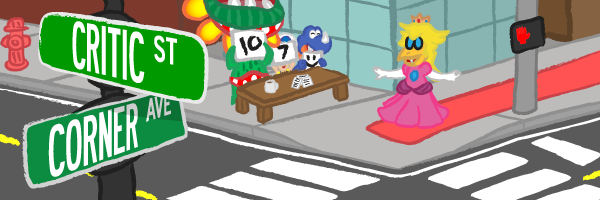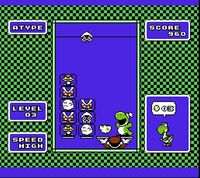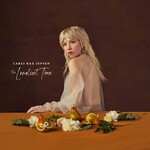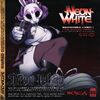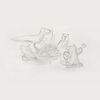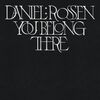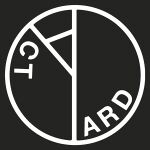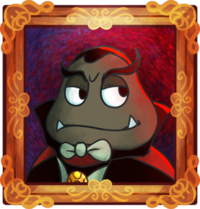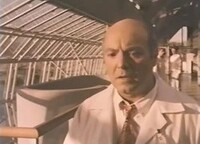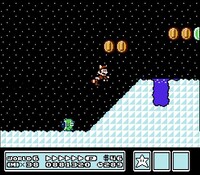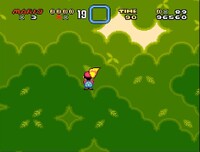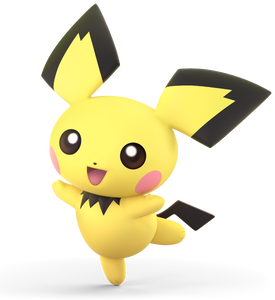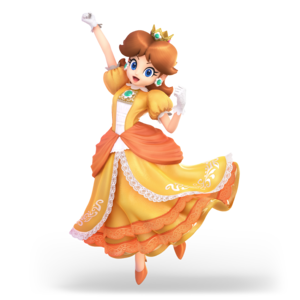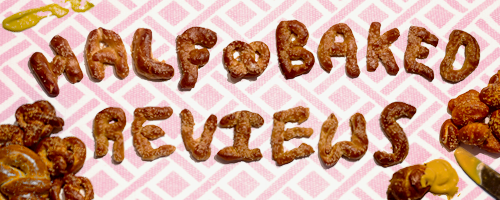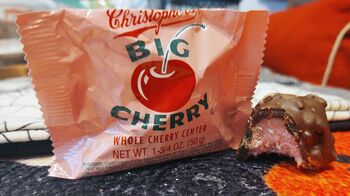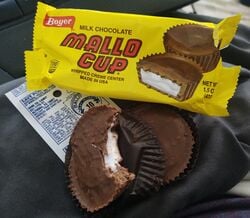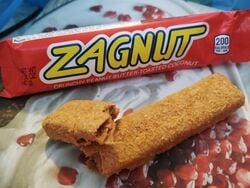The 'Shroom:Issue 190/Critic Corner
Director's Notes
Welcome to the new year! Soon, another year! But for now, please stick with us and enjoy a bunch of reviews from us, including a one-shot review from Mustard Machine (talk) who always puts immense passion into his work!
Thank you for voting Half-Baked Reviews as December's Critic Corner Section of the Month!! Be sure to give your love to all of our sections here, and give a shout out to our writers whether in chat or in their forum threads dedicated to their sections. Be sure to vote vote vote!
And now for my regular announcements: We've decided to implement in Critic Corner something similar to News Flush over in Fake News, where no formal sign-up application process is required for one-time or limited sections. From now on if you just want to send in a single review for something you just read, watched played, tried, whatever, you just have to send me your review privately either to me directly in chat, or in a message to me on the forum at least one week before each 'Shroom is to be released! There's no commitment or obligation to provide a full monthly section (although you absolutely can shift it into one if you so choose), just send us your thoughts on a thing and we'll feature it here! If you have any questions or curiosities about this, please feel free to ask!
As always, if you would like to help Critic Corner, we always have openings for more writers! You are free to write for sections such as Character Review and Movie Review, or really anything you'd like to do! There's no pressure to have a huge section; they can be shorter and concise! The application process is very simple, starting with reading the Sign Up page, and sending your application to Meta Knight on the forum. Any idea you have is welcome, and if you have any questions or need help signing up, please feel free to reach out to myself or other 'Shroom peeps!
Section of the Month
| CRITIC CORNER SECTION OF THE MONTH | ||||
|---|---|---|---|---|
| Place | Section | Votes | % | Writer |
| 1st | Anton's Half-Baked Reviews | 16 | 59.26% | Hypnotoad (talk) |
| 2nd | A Report on the Effectiveness of Power-Ups | 6 | 22.22% | Mustard Machine (talk) |
| 3rd | All-Time Smash Merit Ranking | 2 | 7.41% | SonicMario (talk) |
| 3rd | 'Shroom FM | 2 | 7.41% | MrConcreteDonkey (talk) |
In Defense of Yoshi (Not that One)
Written By: Mustard Machine (talk)
When you think of Mario puzzle games, what do you think? The majority of you will probably think of the escapades of Dr. Mario, eliminating viruses in the aptly-named Dr. Mario games. Others, especially those following past Awards tournaments, might think of the reskinned Panel de Pon port (and winner of least-applicable name award) Tetris Attack on the SNES. Finally, the truly enlightened might think of Toad's spotlight game Wario's Woods. There are, of course, a number of other puzzle games in the Mario series, such as Mario's Picross, the fantastic Donkey Kong 94 and its assorted sequel Mario vs. Donkey Kong games, and the other Yoshi puzzle game titled Yoshi's Cookie. But amongst all the puzzles Mario has been a part of, there's one that gets overlooked, and, when it does get remembered, it gets treated with scorn. That games is the other "other Yoshi puzzle game", the creatively-named Yoshi, originally released for the Nintendo Entertainment System and the Game Boy. Now, you probably haven't heard of this game, and, if you have, it's probably because you saw it on the Switch's NES app. Maybe you played it, or maybe you ignored it. If you did play it, you probably didn't play it for long, and why should you? After all, it's just a simple little puzzle game. Well, that's where you're wrong, and, with this section, I'm going to tell you why Yoshi is the hidden gem of the Mario puzzle games.
Developed by Game Freak, Yoshi is a falling block game where the blocks are familiar Mario enemies. There are six kinds of blocks that fall, those being:
- Goomba
- Boo
- Blooper
- Piranha Plant
- Bottom part of a Yoshi Egg.
- Top part of the Yoshi Egg.
The game board consists of four plates (columns) that stack eight (seven in the Game Boy version) high. The player controls Mario, who can shift the plates around while the enemies fall. The goal is to eliminate the enemies to score points. There are two ways of doing this. The first and easiest is to stack two of the same kind of enemy on top of each other. For example, if you stack two Goombas on top of each other, they will both explode (or whatever). The other harder way is to stack enemies on the bottom of a Yoshi Egg and then to close the egg by letting the top part fall on the stack. This eliminates everything in the stack, not only gaining you a lot of points, but also hatching the egg into a new Baby Yoshi.
One detail I like is that you get different Yoshis depending on how many enemies were in the egg. For example, an egg that only had one enemy (or even zero!) will produce only a regular Baby Yoshi and only be worth 50 points, but an egg that has the maximum amount of enemies produces a special Star Yoshi worth a whopping 500 points! The game ends like games such as Tetris and Panel de Pon end, giving you a game over if you fail to prevent a column from stacking nine blocks high.
Now, you might think that this game sounds pretty simple, and, well, that's because it is! Unlike most puzzle games, there isn't really a combo system outside of the eggs. There's no way to stack more then two of the same enemies on top of each other. Here's the thing, though. I think simplicity is its strength. It's very much a puzzle game that anybody can pick up and play. The barrier of entry isn't particularly high, but that doesn't mean that there's no challenge. Since, in normal circumstances, only two blocks drop at a time, there's already a 2/3rds chance that you won't get a block something that you can use to immediately eliminate something in your stacks. Then you factor in that you can get the bottom halves of Yoshi Eggs, which, once an enemy is on them, can only be eliminated with the top of a Yoshi Egg, further reducing your options. Than factor in the fact that as you progress the game gets faster and as your stacks get higher, leaving you with less time to react to the next block. You can see how the game becomes a frantically fun challenge as you desperately try to keep ahead of the next falling block. At it's core, it's a very simple game and that's not bad, because anybody can understand it. Simple doesn't mean easy, and, once you get the levels into the double digits, the pace picks up dramatically and you'll be frantically making moves just to stay afloat.
The game breaks down into two different game modes (three if you consider multiplayer), those being Type A and Type B. One thing to note is the game doesn't have what you might call "standard "difficulty settings. Instead, on the menu screen, you can decide to set the block speed to either "low" or "high". You can also set the level you start at in each mode (from 1-5), so, if you want to start with a little more difficulty, you can! Type A is basically an endless mode, where the game goes until you lose. The goal here is pretty self-explanatory, as you just play as long as possible to get as high of a score as possible. If you manage to hatch ten eggs, you'll get a little bonus when you get a game over where the eggs will hatch for extra points. Type A goes on forever, but the level maxes out at 99. Obviously, the main challenge for Type A is that, as you advance levels (which you advance through based on the points you have), the game gets faster. One little hook this mode has is that, after level 5, the game starts throwing sections where, instead of two things dropping, it'll drop three things. This might not sound like a lot, but you only have four columns, so increasing the amount of things that drop by one does a lot to add tension to the gameplay. Now you have even less time to react as you move the columns around.
Type B has a little more meat to it and it's kind of the closest thing Yoshi has to a campaign. In Type B, the goal is to clear a level by completely erasing the field. So, in this mode, unlike in Type A, you start with things already filling your columns.
In level 1, only the first row is filled across your four columns, but by level 6 and onwards, the game starts with six of the rows filled in every column. Type B also has a timer and you're awarded more points based on how quickly you complete the stage. Completing a stage gives you a cutscene where Yoshi (with Mario riding him) eats an item (some from the Mario series, some not) that's worth bonus points. I assume this one also goes to level 99, as well? I couldn't find anything online about an ending, because, weirdly enough, people don't like Yoshi. What I do know is that, at level 28, the item is a P-Switch worth 1,500 points, and every stage after that has the P-Switch. Once again, the mode ends if you let a stack reach the top. Of the two modes, I probably prefer Type B. Type A is still fun and it's better for more casual play, and, yes, it's true that both modes are all about getting the highest score, but I feel like Type B is more challenging and has a little more meat on the bones, what with the player working towards a goal and getting little cutscenes when you clear a stage.
There's also a two-player mode that's pretty fun (and it's the only way to play as Luigi). Two-player mode plays like Type B, with the goal being to clear the stage of blocks. It does have its own gimmick where any enemies that you put into eggs get sent over to your opponent's side, giving you more incentive to make as many eggs as possible. Whoever wins the round, either by having more points at the end of the round or by causing their opponent to get too high of a stack, receives a round victory. The game ends when a player wins three rounds. Two-player mode is pretty fun; it's a nice little mode if you've got a friend to play with.
I love Yoshi. I always have and it has always saddened me that it has such a poor reputation. I find the gameplay simple yet fun. It doesn't have deep gameplay mechanics even for a puzzle game, but, honestly, it doesn't need them. It sets out to be a fun puzzle game that you can waste some time with, and I think it succeeds. I've always liked this game. It's probably one of my favorite standard Mario puzzle games, and I can only hope that, after reading this, maybe you'll give it the chance it deserves.
'Shroom FM
Written by: MrConcreteDonkey (talk)
Welcome to the 'Shroom FM Awards 2022. As with last year and the year before, this will serve as a best/worst/etc. of 2022.
Honourable Mentions
To start on a positive note, 2022 has probably been my favourite year for albums since 2019, after 2020 was a bit lacklustre and 2021 was maybe even worse. As such, I've got quite a few album this year I want to give an honourable mention to.
- Carly Rae Jepsen's The Loneliest Time and Florence + the Machine's Dance Fever - the two final cuts I made from my top 40. Both very good albums; I don't think the former is Carly's strongest work but still there's plenty of highs and it's still consistently fun; meanwhile, Dance Fever is engaging and well-written, with very rich instrumentation and vocals.
- Nu Genea's Bar Mediterraneo - a fun, energetic and catchy funk album.
- Sometimes, Forever by Soccer Mommy - very solid, great guitarwork.
- Beware of the Monkey by MIKE has a bit of a weak start but the highlights definitely make up for it.
- Mild Sorrow Integrated's arbol and Fergus McCreadie's Forest Floor, both very fresh and bright instrumental albums.
- elllegy by The Olllam and Omnium Gatherum by King Gizzard & The Lizard Wizard. I've listened to albums by both of these bands before but they haven't really clicked for me until this year. I realise in King Gizzard's case they have released a ton of albums this year but I've only managed to listen to this one so far.
- Let's Eat Grandma's Two Ribbons didn't do as much for me as their previous album did, but was still a good project.
- Finally, PVA's BLUSH was a lot of fun and I'm excited to see what they do next.
Top 40 Albums of 2022
Best EPs of the Year
In contrast to albums in 2022, I've not really found many EPs that have done much for me in 2022.If I had to pick a favourite, I'd probably go for Sun's Signature, the eponymous EP from a duo consisting of Cocteau Twins' Elizabeth Fraser and her partner Damon Reece. It doesn't reinvent the wheel, but it's very pleasant and has the exact sort of nice, ethereal sound you'd expect from it. I'd also recommend checking out Greet Death's New Low if you're looking for some rich, sombre indie rock that really draws you in. BEBÉ YANA's SPACE MULAN was also a nice, catchy pop EP.
Other than that, the two Asian Glow projects I listened to - Weatherglow (with Weatherday) and Coverglow pt. 1 - were both enjoyable, even if the latter did have a bit of a slow start.
Worst Albums of the Year
I should point out that these are obviously not objectively the "worst albums of the year" but they're the ones I enjoyed the least. I don't even want to know what the worst album of 2022 was. Probably Drake.Quite a few artists I've enjoyed in the past have released albums this year that I've found really tedious. Firstly, Hold the Girl by Rina Sawayama is just so flavourless and bland in comparison to everything else she's released. Chat Pile's God's Country has received a lot of acclaim but it just felt like a dumbed down version of their earlier EPs, with none of the personality or fun carried over.
Meanwhile, Jockstrap's I Love You Jennifer B was trying far too hard to experiment and just ended up doing mostly nothing. Sharon van Etten's We've Been Going About This All Wrong had a similar problem, trying to pile in so many "epic" songs that everything sounded practically the same. With both of these albums, the songs that tried the least hard were the ones that felt most complete ("Greatest Hits" and "Mistakes", respectively).
However, my least favourite album of 2022 was definitely Yard Act's The Overload, an album that relies heavily on a very tired and outdated bit. Musically it's got the same bland delivery and uninteresting sound as many other post-punk bands from the UK, with very little else to distinguish it from the crowd - and a really smarmy attitude to top it all off. To give it some credit, the track "Tall Poppies" is pretty good and lyrically engaging - but overall, really really annoying.
2022 is now dead. Goodbye 2022. Thank you for reading.
Van Shoeul's House of Ghouls
By: Mustard Machine (talk)
| 12:01 PM | |
|---|---|

| |
| Genres | Horror Sci-Fi |
| Release date | 1990 |
| Starring | Kurtwood Smith, Don Amendolia, Laura Harrington |
| Directed By | Jonathan Heap |
| Runtime | 27 minutes |
| Streaming | YouTube |
Good evening, dear readers, and welcome to Van Shoeul's House of Ghouls. I'm your host, Vincent Van Shoeul. For tonight's performance, we look at one of the most terrifying tales of all, a tale whose terror comes not from gore, not from monsters, not from murder, but instead from the horror of time repeating itself. Tonight's tale, 12:01 PM, may not appear to be a horror film. It lacks the blood and guts you may be accustomed to, but I ask you, dear reader, what could be scarier than repeating the same hour over and over again? What could be more grim than being the only person to realize the world is in a loop and being unable to do anything about it? That, dear readers, is the plight of the hero of tonight's story, but before we go any further, I must warn those of you whose hearts have already dropped to go no further in this section. For those of you brave enough to continue, I can promise you that this will be a thriller.
For tonight's featured performers, we have Jane Alden as Stephanie, haughty secretary for Myron Castleman; Laura Harrington as Dolores Park, a sympathetic ear for Myron to vent to in his cruel loop; and Don Amendolia as Professor Nathan Rosenbluth, a Nobel Prize winning scientist whose predictions may just help Myron escape his hell. Finally, we have Kurtwood Smith as Myron Castleman, a man doomed to relive the same hour for eternity.
Based on the a short story bearing the same title, 12:01 PM was produced as part of Showtime's The 30-Minute Film series, a series that, as the name suggests, consists of short films that last thirty minutes. The story follows Myron Castleman (played by Kurtwood Smith of That 70's Show fame), a mid-level employee at the firm Glamdring and Glamdring (although he is important enough to have a secretary), who has become trapped in a time loop that begins at 12:01 PM and always ends at 1:00 PM. As soon as the clock strikes 1:00 PM, it happens, a crackling sound followed by darkness, in turn followed by a bright light and colors. Finally, he awakens back in the same spot he started in, right in the middle of the busy street with the sounds of traffic all around him.
He always starts hungry because he hasn't eaten lunch yet. As he himself says in the film, "even if I ate at 12:59, I'd be starving again in two minutes". A great little detail in the first shot is that Myron appears to start the film waking up in the middle of the street. He lets out a depressed sigh as he drearily goes on his walk down the street and into a park, which is the same walk, we later learn, that he's done between 30-40 times already. This time is different, though. This time, he decides to ask a woman (played by Laura Harrington) sitting on a park bench if he can eat his lunch next to her.
This first loop is one of my favorites in the story, because, after he sits down, we get a lot of character establishing. One of the best little subtle bits is how, after the woman (Dolores Park) asks him how he's doing, Myron stares at a park clock in horror before answering. Drawn in by Dolores' kindness, such as the way she gives a homeless man money and compliments Myron on his lunch, Myron strikes up a conversation with her. This is where we begin to learn a little bit about Myron. He's an employee at a prestigious firm called Glamdring and Glamdring, where he's worked for 23 years, though he says he's still a little guy in the company though. Dolores tells him he sounds like he needs a change, to which Myron says this was going to be his year but now it's too late. Finally, Myron tells her the horrible truth, telling her that he's stuck in a time loop and that, as soon as the clock hits 1:00 PM, time snaps back to 12:01 PM and that he's the only one that remembers. Kurtwood Smith is great in this scene and, really, in the whole movie. The fear in his voice, his desperation to make Dolores believe him, his breaking down and bitterly lamenting that it's all starting to seem normal to him, the film and Smith do a great job in this loop of making Myron seem human, like just a guy that the audience can really feel for. Then there's actually a really cool detail where, after all this, Dolores hugs Myron to calm him down, but then time begins to repeat and it's implied that Dolores realizes something is happening with her, with her asking Myron what's happening right before time resets. It's never elaborated if that's just something everyone can feel when time loops or if that's just because she was touching Myron.
Regardless, time returns to 12:01, and we get a really good example of why this time loop is so terrible, because Myron then seeks out Dolores, but, once he talks to her, he's dejected when he realizes she doesn't remember him. He is truly is alone in this loop. Myron, by chance while walking around dejected, manages to find a newspaper with a headline about Nobel Prize winner Professor Nathan Rosenbluth, who predicted the world could be stuck in a time bounce. Sprinting to his workplace, Myron manages to get his insufferable secretary Stephanie (played by Jane Adler) to get the professor on phone. To the film's credit, we actually get an explanation as to why this is happening! Basically, a matter and antimatter world collided, causing the time bounce. As to why Myron is remembering it when nobody else is? Well, the professor hypothesizes that human consciousness is independent of the mechanics of the universe, so it's possible for a human's consciousness to be essentially left out of the loop, so, while the body and the universe are repeating, the brain itself is not. It's a very silly explanation, but, you know, it is cool that at the very least the viewer is given a reason why this is happening where a lot of these kinds of films just kind of go "this is happening, deal with it". Unfortunately, before Myron can get more of an explanation, the clock strikes 1:00 and the universe resets. Then we get another great bit of acting where Myron gets the professor on the phone again but then freezes in abject horror when he sees that it's already 12:35, ultimately spending the remaining 25 minutes staring silently into a clock. Through just facial expressions alone, Kurtwood Smith does a great job of portraying just the absolute horror of a man who knows he's doomed to suffer a terrible fate
One of the best and honestly scariest parts of this whole concept is that there's no lesson. Like, this isn't the kind of story where the hero eventually learns his lesson, or gets the girl, or saves the world and finally escapes the time bounce. No, this a story about a man who, through nothing he has done, is just stuck in this loop and there's nothing he can do about it. This is best exemplified in the next loop, where he does all these things that, in a different story, might allowed him to escape. He pulls a man out of the way so a bird doesn't poop on him, he helps a homeless man and defends him from some people who are bullying him, and he even manages to get his girl by securing a date with Dolores! But it doesn't matter! As soon as the clock hits 1:00 PM, time resets. This story is the equivalent of that "was that fucked up or what? Anyways I'm Rod Serling" Twilight Zone meme. It's the perfect kind of horror, a kind where you genuinely feel bad for this man who, by all accounts, is a perfectly fine guy trapped in this fate that he has neither caused nor deserved. Again, Kurtwood Smith does a fantastic job portraying all these emotions, going from despair to anger and back repeatedly as he goes from loop to loop.
Then there is the ending, which is fantastic. After enough loops, Myron has finally had enough and manages to get a meeting with Professor Nathan Rosenbluth. At first, the professor dismisses him as a quack, but Myron convinces him that he's telling the truth by telling him he was right about consciousness being an independent variable (something the professor had never told anyone). Myron then begs the professor for help, asking him if the time bounce will ever end, if there's anything the professor can do.
The professor can only shake his head sadly before hugging Myron in an attempt to comfort him. Myron then completely breaks down, going on to declare himself god since he's the only one that can truly influence the world. He's the only one that can change anything, he says. Stealing the security guard's gun, Myron Castleman shoots himself in the head in a desperate attempt to end his suffering, but, then 1:00 PM hits and Myron wakes up right where he always does. There he is again, right in the middle of a busy street, starving and surrounded by noise. He can only look on in horror as he realizes not even death will allow him to escape the never-ending loop.
The whole ending scene is a masterclass in both storytelling and acting. Kurtwood Smith effortlessly runs the gambit of emotions, from his desperation to get the professor to believe him to his terrified begging for the professor to come up with something, anything that can help him. Again, even through just facial expressions, Kurtwood Smith easily manages to portray a desperate broken man looking for any sign that he can escape this hell. He then does a great job of portraying a man who has gone completely mad upon the realization that there isn't anything anyone can do to help him. I also want to give a shout-out to Don Amendolia, who does a great job portraying a man, at first, dismissive of Myron, treating him like a quack with simple actions like rolling his eyes and beginning to walk away. Then he transitions into a man horrified to find out that his predictions had come true, with a special mention going to a part where, upon Myron explaining what the transition was like, he can only say "so I was right" before the realization of what this means dawns on him, causing him to look down horrified and to keep muttering "so I was right." The part where he hugs Myron is great because it really feels like he's trying to do anything he can think of to help a man whose situation he can completely understand while knowing there's nothing he can do to help. Like I said, the ending is fantastic and is just a masterclass on how you do an ending.
I think the ending of the film is much scarier than the ending of the short story. While they share the same basic idea (Myron Castleman dies and then reawakens still stuck in the time loop), the way they do it is different. In the short story, Myron never actually meets the professor. Instead, he only talks to him on the phone one time. He spends the next three loops trying to get him back on the phone before dying from a heart attack due to stress. So, in the short story, it's still possible that, if he manages to get back into contact with the professor, he still could be helped. The film, on the other hand, completely crushes that possibility by having the professor, the only person that could possibly help, sadly dismiss the possibility that anything can be done. While the short story has a glimmer of hope, however small, the film has no hope. Myron is stuck forever and there isn't anything either he or anyone else can do about it.
12:01 PM is a both a truly terrifying tale and a fantastic little movie, something the Academy Awards would agree with, nominating it for the Academy Award for Live Action Short Film (it didn't win though). I really do think it's one of the scariest films, because, while, yes, monsters and death are scary, death is it, ya know? If you die, that's all there is to it. But this is the opposite of death. This is eternal life, but life in such a state where it would be better to be dead. An hour is a very short amount of time, especially if you're starting in the middle of the street and hungry. For a lot of people, they wouldn't be able to do anything in that hour before it repeats. Even if you tried to plan it out, what could you really do? You only have an hour before everything repeats. It's a somewhat subdued horror, because it plays on the reality that eternal life is a curse if you aren't able to enjoy it. At a brisk 27 minutes and available for free on YouTube, I think it's a must watch for any sci-fi or horror fan.
That, dear readers, concludes one of the scariest tales ever presented on our little program. The moral, you ask? It's quite simple. If you ever get stuck in a time loop, well... uh... don't get stuck in a time loop. With that, dear readers, this section comes to an end. I've been your guide through the catacombs, Vincent Van Shouel, welcoming those of you brave enough to join us next month for another Van Shouel's House of Ghouls.
Book Review
| The Girl Who Fell Beneath the Sea | |
|---|---|
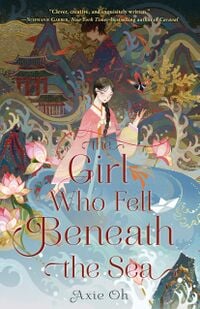
| |
| Author | Axie Oh |
| Release date | 2022 |
| Genre | fantasy |
| Pages | 336 |
| Available From | |
Greetings, readers, and welcome to a new year of Book Review! This month, I will be reviewing The Girl Who Fell Beneath the Sea by Axie Oh!
Certainly not a timely pick, as this book came out early last year, but in a year packed with good books that I wanted to review, I figured I would carry it over to this year as it was my #2 favorite book last year and I want to talk about it. This one was a recommendation by Barnes and Noble, I believe, and I was captivated by the cover art and intrigued by the summary, so I put it on my release schedule. It's a retelling of a Korean folktale called The Legend of Shim Cheong.
The Girl Who Fell Beneath the Sea tells the story of Mina, who lives in a village by the sea. Each year, to appease the Sea God, the villagers offer up a young woman to be his bride to prevent their village being destroyed by his wrath. This year, the bride will be Shim Cheong, who Mina’s older brother Joon is in love with. He intends to come with her on her boat ride out to the ocean where the offering will be made, and thusly, Mina stows away on the ship in order to offer herself up to the Sea God out of love for her brother. Once she is transported to the palace of the Sea God, however, the red thread linking her and the sleeping sea god is severed by a strange group of black-clad figures and her voice is stolen away. In her quest to get her voice back, however, the red thread of fate mends itself between her and the leader of the mysterious group. Mina has 30 days to wake the sea god out of his nightmarish slumber and return to the surface world, or else she will become a spirit and will not be able to return to the surface to see her brother or her family ever again.
The Girl Who Fell Beneath the Sea is a very comfortable story. It’s a book that you want to curl up with in a plushy chair with a warm blanket and cup of hot cocoa and read while it’s raining outside. Whereas a book like Iron Widow can be very jarring at points and Daughter of the Moon Goddess turns into a breathtaking high speed ride, this story feels softer, in a way. That doesn’t mean that it’s not as good as those two books, however. It can hold its own on the shelf with those two, and its softer tone makes for a kinder read than Iron Widow and its lower page count and weight makes for a shorter read than Daughter of the Moon Goddess. It’s a book I’d like to give a big hug to, honestly. The setting of the Spirit Realm is elegant but familiar, like a fancy restaurant that your parents took you to when you were a kid that you've always kept in the back of your mind, and I'd love to see another story from Oh in a setting like this.
Let’s talk about Mina now. She’s a great protagonist, and she kinda reminds me of Belle from Beauty and the Beast. She's smart and brave, and she doesn't let others push her around. Mina does what she does out of love for others, and I love characters with that kind of motivation. She doesn't ever give up, and she's the kind of protagonist you look up to, someone you want to be when you grow up, even if you're already a grown up. I love Mina, and I'm rooting for her the whole way through.
The Girl Who Fell Beneath the Sea is a delight to read. I honestly can't recommend it enough to you. If you like to read fantasy stories, or if you've ever watched a movie with a Disney Princess and thought "I want to be just like her", then this is the book for you. Add it to the collection of Asian-inspired tales I've recommended over the past couple years.
That's all for me this month, readers! I have a lot planned for this new year, and I'm so excited to share some great books with you! Tune in next month for a new Graphic Novel Review, and I'll see you then!
A Report on the Effectiveness of Power-Ups
Written By: Generalissimo Shoe (talk)
At ease, troops and welcome to another information briefing on the tools we use to combat the Koopa Troop. Last month, we looked at weapons for intergalactic warfare. This month, we're going to be looking at weapons that allow our troops to take to the sky.
P-Wing
One of three flight-based power-ups in Super Mario Bros. 3, the P-Wing turns Mario or Luigi into P-Wing Mario or Luigi (Raccoon Mario but with a big P on his overalls), and grants him the same powers as a Super Leaf does (flight and defeating enemies with the tail) with one notable difference. If you use a P-Wing, you are granted infinite flight in the first level you use it in. You don't even have to run to fill up the P-Meter; you can fly from the start! Because of this, the P-Wing is the best power-up in the game allowing you to beat just about any level (outside of underwater levels) without the threat of being damaged.
It's great for those really tough levels. Also, while you lose the ability to fly infinitely after completing a level, you still keep the Raccoon Mario form. The P-Wing is kind of broken, but it's not really, because the game does a pretty good of balancing it. There are only a total of nine P-Wings in the game, with three being given to you after completing airships (Grass Land, Giant Land, and Ice Land), two being obtained after defeating a set of Hammer Bros. on the world map (Giant Land and Sky Land), and, finally, a total of four that are obtained by unlocking the White Toad house at the end of levels 1-4, 3-8, 5-5, and 7-2. That's only a max of nine P-Wings in a game that has 90 levels, so, while yes they are broken in the sense that they make almost every level a joke, the fact is that you're really only going to be using them in levels that you just can't beat otherwise.
The P-Wing, as a power-up at least, makes only one further appearance in a mainline Mario platformer, appearing once again in Super Mario 3D Land. Here, though, it functions quite a bit differently than it does in Super Mario Bros. 3. In Super Mario 3D Land, the P-Wing appears as an optional assist item. In a regular world level (so this excludes the Special Worlds), if the player dies more than ten times in a level, a P-Wing box will appear. If the player grabs the P-Wing from the box, they will automatically be transported to the end of the level. Unlike in Super Mario Bros. 3, you will not become Raccoon Mario, so it's basically just even more of a level skip item. It's honestly kind of weird that they brought it back for this game, because the game already has an easy mode item, that being the Invincibility Leaf which appears if you lose five lives in a level, turning Mario into White Tanooki Mario. White Tanooki Mario is basically like having a Super Star that's combined with a Tanooki Suit, but at least you're still playing the level and you're still playing the game. The P-Wing, by contrast, is just an outright level skip, so if the Invincibility Leaf is easy mode, then the P-Wing is super easy mode. I just think it's kind of odd that they'd add a super easy mode in a game that already had an easy mode.
I like the P-Wing and I'll fully admit I can't complete Super Mario Bros. 3 without using it, but I can totally see why it hasn't made very many appearances in Mario games. It's not really a power-up; rather, it's a get-out-of-hard-level card. I'm not against it for players that are struggling, but it's really kind of just been replaced by forms like White Cat Mario and White Tanooki Mario, forms that, while still an easy mode, are more active and let you enjoy the game where the P-Wing just kind of skips the level. A level skip button is something I just don't think most Mario games really need.
Cape Feather
First appearing as the flagship power-up in Super Mario World, the Cape Feather turns Mario into Cape Mario. The main power of this power-up is that, after a running start, Mario is able to fly through the air, much like Raccoon Mario can. Cape Mario's flight is different, though, and has a lot of different mechanics that go with it. Obviously, the main one is, flight which works pretty similar to Racoon Mario's flight in Super Mario Bros. 3, only there's no onscreen meter like the P-Meter. One difference, though, is in the air. If the player presses the D-pad down in the opposite of the way they're flying, Mario will do a little gliding hop, extending his air time. This can be done as long as Mario is in the air. It's pretty difficult to master and I'm not great at it, but, if you master it, you can basically finish entire levels with it. If you hold the D-pad down the the same way you're flying, Mario will do a dive bomb attack that will kill any onscreen enemy once he lands, with the attack working similarly to a Yellow Yoshi's earthquake ability. Mario even has defensive properties while flying! If he collides with an enemy in the air, he'll go into a spin jump rather than taking damage. Speaking of the spin jump, pressing the spin jump button rather than the regular jump button once you've run far enough will cause Mario to take to the sky with a spin jump rather than take off into his regular flight.
Cape Mario probably had the deepest flying mechanics in any Mario game until the Red Star from Super Mario Galaxy came along, and, in terms of 2D Mario games, it's really unmatched. There's just so many different things you can do while in the air. There is so much potential to manipulate it and you can also fly while riding Yoshi (though you lose access to everything but flight).
Cape Mario even has some powers unrelated to flight, such as a longer jump when you spin jump off an enemy. As well, much like Raccoon Mario could defeat enemies with his tail, Cape Mario can defeat enemies by spinning his cape. I think the cape is stronger, though, because the tail in Super Mario Bros. 3 had weird hit detection and it seemed really random what enemies could actually be defeated by the tail, where the cape doesn't have those problems and I find it much easier to defeat enemies with it. The Cape Feather even makes regular jumps easier, because the cape lets Mario glide as he descends. This allows Mario to move farther and have better control over his landings.
Surprisingly, while the Cape Feather would go onto appear as an occasional item in Mario Kart series, Cape Mario makes very few appearances in the main series. It's in the Game Boy Advance's Super Mario Advance 4: Super Mario Bros. 3, but it's only in some of the levels of World-e, which since players require an e-Reader to get those levels, very few people have played (unless you had the Wii U port, which has those levels unlocked by default). Here, it functions exactly the same as it did in Super Mario World, with the only real upgrade being that you can stack it with the temporary Boomerang power-up that appears in a few levels. It also appears in both Super Mario Maker and Super Mario Maker 2, where it only appears in the Super Mario World level style. It plays exactly the same in these games as it did in its original appearance, with no tweaks at all. These are the only further appearances of Cape Mario in mainline Mario games. It also appears as Mario's side-B move in the Super Smash Bros. series, where, if it hits the enemy, it both damages them and spins them around.
It's honestly a little weird that the Cape Feather makes so few appearances in the Mario series, because not only is it a great flying power-up with depth that has never been matched in the 2D games, it's also one of the most iconic power-ups in the entire franchise. Really, outside of the staple power-ups like the Super Mushroom, Fire Flower, and Super Star, the only power-up that could even come close to it in terms of how iconic it is is the Super Leaf. It's so wild to me that you have a power-up that's both so great and iconic and yet it never appears. It absolutely could make a comeback and I really think it should, because, again it's probably my favorite of all the the 2D flight-based power-ups in the series.
With the skies now secure thanks to our cape and newfound infinite flight, that'll bring another report to a close. I hope you'll join us next month when we continue looking at weapons to be used in our eternal battle with our age old foe.
All-Time Smash Merit Ranking
Written by: SonicMario (talk)
Welcome to the first Smash Merit ranking of 2023! Though there really isn’t much left after this. The voting for the entire rest of the schedule is just about finished. And by April all characters will be accounted for. Our non-shroom sections this time were Wolf, Pokémon Trainer, and Villager.
For today’s characters, we have two Smash characters who are both on the bit of an underdog or even outright scrappy-tier in many circles for one reason or another. They are also both characters who debuted on the Game Boy.
| Categories | Fighter Info |
|---|---|
| Fighter Number | 19 |
| Fighter Group | Melee Veterans |
| Franchise | Pokémon |
| Game of Origin | Pokémon Gold/Silver (Game Boy, 1999 (JP), 2000 (US), 2001 (EU) |
I’ve mentioned many times already about how Gen 1’s hey day was the peak of the Pokémon phenomenon. The games definitely would improve upon what the core of Red, Blue, and Yellow introduced. But at almost no point past those first few years have Pokémon quite matched the utter boom it had at the beginning. And that’s ok, as part of the reason it was such an explosion is that it was an obvious fad that can’t last in the public consciousness forever. Pokémon still grew to be one of the largest media franchises ever made but only Gen 1 do you really have people who haven’t followed the series that much vaguely aware of many of its Pokémon. Perhaps the only generation that could argue it still had some of that general public love, was the very next one since Generation 2 naturally would be an exciting expansion of what Generation 1 had.
Generation 2 expanded quite a bit on the first Pokémon but what most relates to our next discussed fighter, is the idea of Baby Pokémon. Pokémon that initially were the first evolution in Red, Blue, Yellow but now suddenly became either the final or even a middle evolution. There was Cleffa for Clefairy, Igglybuff for Jigglypuff, Tyrogue for both Hitmonlee, and Hitmonchan (With the option of a new evolution choice of Hitmontop), Smoochum for Jynx, Elekid for Electabuzz, and Magby for Magmar. Though obviously we’re here for only one particular baby Pokémon. A pre-evolution for the mascot of the series itself: Pichu.
Now in a lot of ways, Pichu’s been a bit of a running joke in Smash Bros. history. Due to it being pretty terrible in Melee and some of it’s most damaging moves hurts itself in the process of being used. Pichu arguably has more right to be called a joke character as it’s a pretty active handicap. Potentially just used for someone to demonstrate their skill at Melee if they wanted to brag how good they were by playing as Pichu and still beating the snot out of your friend or foe. That said, even if it is a bit of joke character. It still is Generations 2’s representative and they didn’t just include Pichu for the sake of the joke. Pichu was obviously made to be marketable, and even got some feature in the Anime via the Pichu Brothers. Which even got a cartoon that (Well, outside of just watching it on Youtube) was exclusive to Pokémon Channel. A game that was pretty much a sequel to Hey You, Pikachu! (If a bit weird, since the main objective is to watch TV… on your TV… but with Pikachu)
Understandably, Pichu did not return in Brawl or Smash 4 as Gen 2 was past it’s time. Although because Pichu could wall jump in Melee while Pikachu couldn’t. An ongoing theory happened that the Pikachu in 64 and Melee has retired and Melee Pichu grew up to be the current Pikachu we’ve had since Brawl. Maybe the reason Pikachu is so good competitively in Ultimate is it’s been leveling up since Brawl, and it even now has it's own Pichu apprentice that actually isn’t too terrible at fighting either. There’s no solid proof for or against this. But it certainly makes for an interesting head canon.
I will say that Pichu is something that probably only returns just for the Everyone is Here aspect, but I can respect the number of people who missed Pichu being on the roster anyway. I think they understood why Pichu didn’t come back, and while they may have wished it would come back. Never expected it, so for them Everyone is Here was definitely special, even among other characters that people thought would never come back to Smash.
So here’s to you, Pichu fans. Forever the cute little underdog
As much as I leave some good will for Pichu… I’m afraid it’s not as reserved as much for our #1 Pick this time
| Categories | Fighter Info |
|---|---|
| Fighter Number | 13e |
| Fighter Group | Ultimate Newcomers/Echo Fighters |
| Franchise | Mario |
| Game of Origin | Super Mario Land (Game Boy, 1989 (US/JP), 1990 (EU) |
Sigh… Oh Daisy, oh Daisy, oh Daisy…
Let’s get one thing out of the way, is that of course there’s no other way Daisy would have gotten in Smash without being an echo fighter. The competition for a Mario spot is quite stiff (For the sole exception of the joke inclusion that was Piranha Plant). I will say I’m mostly lukewarm to the character itself. It’s… just a bit of a history with some of her, or at least just one of her, overzealous fans that can leave a bad taste in your mouth whenever you see her. I won’t name names, but many in both the Mario and Smash Bros. community are probably at least vaguely aware of a particular Daisy fanatic. They made it their business to be that kind of fan that practically throws their obsession in your face.
It’s true that Daisy got into Smash despite everything, but it feels like the ultimate Monkey’s Paw. You can play as Daisy… but she’s literally outside of cosmetic differences… The laziest Echo Fighter in the entire game. There is not one iota of a difference between the way she plays from Peach. Even Dark Pit at least has a different Final smash and a slight difference on the side special. It ironically proved Daisy’s detractors right that they wouldn’t differentiate her much from Peach. Some fans of Daisy are just happy to have Daisy playable at all and I think we can be happy for those who are fine with what they got, knowing full well this was the best Daisy was ever going to get at this point. The problem comes with those that we know who demanded Daisy could be entirely original but quickly turned around to say how Echo Fighters are the best thing and also claim that there IS a significant difference between the way Peach and Daisy play that others are too blind to see.
Perhaps the character fans most victimized by the inclusion of Daisy. Is Waluigi’s who shares a resume not unlike Daisy. Where for the exception of Super Mario Land, where she was… you guessed it… a stand-in for Peach. She and Waluigi have been relegated to nothing but the Spin-offs since the N64 era. (And no, I do not include Super Mario Run as a mainline game. Nice try). Daisy still arguably gets some decent spotlight through Mario Kart especially, but otherwise has failed to make an impact on little-to-no Mario main series platforms in a way that Rosalina got to do in Super Mario 3D World. The closest we got to Daisy in an official Mario platformer was her mystery mushroom costume in the original Super Mario Maker… and even then it became a running gag on just how many things came before Daisy finally was a costume. Inanimate objects and even on one occasion a real life Japanese celebrity getting a spotlight before Daisy in the original Mario Maker.
But you get it, Daisy and Waluigi outside of the spin-offs were sometimes mere jokes because of their lack of major mainline appearances. It did shake things a bit when Daisy was made an Echo Fighter, and then Waluigi was immediately confirmed to be back to being just an Assist Trophy. But any Waluigi fans should hear this, because of Waluigi’s circumstances. down to his very character design. Waluigi cannot be an echo of any Smash fighter, while Daisy plausibly could. You can be comforted by the idea that should Waluigi finally have his chance to be playable in Smash he will be his own character because his very design and requests demand it. It’s very possible Daisy had a decent amount of support in the Smash ballot and Nintendo and/or Sakurai was like “You know what, let’s throw them a bone. Make Daisy a copy of Peach in the next Smash Bros.”
And another thing? What if the idea of Echo Fighters return, and Daisy is stuck forever in that purgatory of being mostly a clone of Peach. While Waluigi finally makes it and he’s more fun as a character then Daisy could ever hope to be. I feel the next game may at least try to add some more differences between Echo Fighters. But just like how Ganondorf is still a slower and more powerful Captain Falcon clone to this day. Daisy fans may never truly get their unique Daisy they’ve always wanted. While Waluigi still has that chance. Like I said, Daisy is in… but it’s very much a monkey’s paw for their fans and the mileage may vary if they’re actually satisfied with how Daisy was relegated this way. In a sense, while Daisy did get in Smash before Waluigi… it potentially pushes her out of the way of being represented in her full glory in comparison to what Waluigi could get should he finally get his chance.
As for Daisy herself, I really only have one more thing to say… What was the point of adding Daisy if you weren’t even going to make “HI I’M DAISY” a taunt. I would have at least clapped for the guts to add one of the most annoying lines in Mario Kart history hit a new peak of being a legendary spammable taunt. That’s the real waste of her inclusion.
Now on to the rankings. Both characters are on the lower end of course. Though Pichu might be a bit higher then most of you would think. Despite everything, Pichu was still a significant marketable Pokémon in Gen 2 when Pokémon was still relatively super popular in a way it hasn’t been since. I think it’s fair to say it’s connection to Pikachu does make it very recognizable and right now still has an edge of merit on most non-Gen 1 Pokémon. I am putting Pichu below Wolf, but above Duck Hunt. The latter is quite a bit older, but Gen 2 still being relatively popular in comparison. Heck, the remakes of Gold and Silver. Heart Gold and Soul Silver are almost the go-to answer to when anyone asks what was the best Pokémon game of all-time. That keeps Pichu in a pretty surprising limelight. It also helps soon that Pokémon Stadium 2 will be coming to NSO sometime in 2023 which will have Gen 2 Pokémon like Pichu with some resurgence of a spotlight.
As for Daisy though… she is an Echo. Which itself puts her among our bottom characters. She does outrank the likes of Dr. Mario, as she is at least a separate character. But I have a hard time justifying her over even Chrom. Chrom at least got to star in Fire Emblem Awakening and was a relatively popular choice to get in Smash with his echo fighter status being mostly applauded. Even having a different up special from Roy (Even if it’s just sort of borrowed from Ike). Daisy’s still stuck in spin-off purgatory and as I mentioned before, depending how the next Smash takes Echo Fighters could end up being in Echo Fighter purgatory as well. Something that I know Chrom fans would most likely take if that’s all they get, but I just know there’s a number of Daisy fans who will hate it if Echo Fighters keep Daisy relegated to how she is in Ultimate for as long as Echo Fighters are a concept in the Smash Bros. franchise.
| 1. Mario | 21. Ridley | 41. Snake | 61. ROB |
| 2. Link | 22. King K. Rool | 42. Shulk | 62. Min Min |
| 3. Pikachu | 23. Zelda | 43. Pit | 63. Byleth |
| 4. Donkey Kong | 24. Meta Knight | 44. Ness | 64. Ice Climbers |
| 5. Kirby | 25. Ganondorf | 45. Captain Falcon | 65. Wii Fit Trainer |
| 6. Samus | 26. Mr. Game & Watch | 46. Sephiroth | 66. Chrom |
| 7. Pokémon Trainer | 27. Sonic the Hedgehog | 47. Robin | 67. Daisy |
| 8. Luigi | 28. Cloud | 48. Jigglypuff | 68. Dr. Mario |
| 9. Wario | 29. Sora | 49. Falco | 69. Dark Pit |
| 10. Yoshi | 30. Ryu | 50. Wolf | 70. Piranha Plant |
| 11. Bowser | 31. Villager | 51. Pichu | |
| 12. Peach | 32. Bowser Jr. | 52. Duck Hunt | |
| 13. Mii Fighters | 33. Olimar | 53. Greninja | |
| 14. Mega Man | 34. Fox | 54. Steve | |
| 15. Pac-Man | 35. Rosalina & Luma | 55. Bayonetta | |
| 16. Diddy Kong | 36. Marth | 56. Lucas | |
| 17. Banjo & Kazooie | 37. Zero Suit Samus | 57. Pyra | |
| 18. Simon Belmont | 38. Toon Link | 58. Mythra | |
| 19. King Dedede | 39. Isabelle | 59. Joker | |
| 20. Mewtwo | 40. Inkling | 60. Sheik |
Retro Candy
Retro candy can be difficult to find, whether it’s due to being unremarkable from its simplicity (candy buttons, etc.), a defunct brand, or just the general free market concept that a brand falls into ‘retro’ status because no one wants to buy or sell it anymore. Pretty much by definition it is a niche nostalgia product that exists for sale almost entirely with the affect of reminiscing about when you could buy Necco Wafers on the impulse shelves at your local grocery store’s checkout lanes, as the age of them means nothing when “65 percent of candy bars currently in production have been around for more than 60 years,” and new candy bars from major American brands coming out maybe once a decade. We got press releases calling Creme Savers retro and nostalgia, having been a 90s and 00s darling that has been discontinued only to return a few years later with a new sales pitch, but is anyone saying the same of Butterfinger or Reese's? It’s all just a marketing angle. The only places I’ve been able to find pretty much any retro candy has been Five Below, Rocket Fizz, and a mini golf course in the tourist part of the city, as other places nearby are kept within the theme parks. Your mileage may vary based on where you reside and whether your downtown area still has some old chap selling candy buttons in a shop that can be easily mistaken as a steampunk dive bar. Of course, you can buy anything your heart desires online, but where’s the fun in that?
Hershey’s 5th Avenue
Butterfingers used to be a favorite of mine, an easy pick for something different that still remained similar enough in profile to the ultimate candy Reese’s Cups. Over time, though, I’ve just grown dissatisfied with how thin, fake, and waxy the chocolate tasted, providing very little sweet and creamy balance to the harsh, bitter, tough, and overly thick crunchy peanut butter interior. Here I am, now, in 2023, just now finding out that there exists a better option: 5th Avenue. I’ve seen it around, of course, but really only kept it in my peripherals because I never had any reason to veer off; I could just drop Butterfingers entirely and move onto something like Reese’s Big Cup with Pretzels if I wanted some crunch with my chocolate and peanut butter.
Deemed retro because it has not been advertised by Hershey’s since 1993, and has only been sold through small and niche retailers since, specifically included in their own ‘hard to find brands’. Unable to trust Hershey’s own history timeline as it lists 5th Avenue as debuting in 1986 despite that just being their acquisition date of the candy bar that has existed since 1936, years after Reese’s, Hershey’s Milk Chocolate, Kisses, and other chocolate bars that aren’t considered retro or nostalgia at all. Why is this one retro? Why is it hard to find? What purpose could it carry? Did it lose a battle for this country’s crunchy peanut butter soul when Butterfinger triumphed with its Bart Simpson commercial advertisements that appealed to a younger and more rebellious audience while its own position as 5th Avenue made it appear to be stuffy and pompous? Is it because Hershey’s just randomly selected a few lower ranked candy bars to shift into a hard-to-find category to boost sales utilizing a faux-nostalgia filter and artificial scarcity?
Better flavor, better texture, better chocolate to peanut butter ratio, better shape and size, just all around a perfected crispy peanut butter chocolate bar. A bit thinner than a Butterfinger which lets me take an easier bite without feeling like I have to shatter my teeth or take too huge of a bite just to get it to snap off. The flaky and crunchy peanut butter layers make good use of Hershey’s infamously bitter taste, synergizing with the acidity to give it a rich feeling that gives its luxury name at least some credit. The chocolate also takes more priority in this than it does in a Butterfinger, which I believe helps smooth out how crumbly it could’ve been. Doesn’t stick to my teeth as much as a Butterfinger either. I don’t intend on making this whole review a comparison to Butterfingers but 5th Avenue certainly did confirm my soft bias against Butterfinger already, confirming that there is a better way to do it. The only flaw I could find with it is that it dares to be made from a food that begins to melt at Florida room temperatures, which simply encourages me to become wealthy enough to not be concerned with setting my air conditioning to 68F.
Christopher’s Big Cherry
Despite being branded with the name ‘Christopher’, the company behind it is actually Adams & Brooks, also responsible for Coffee Rio and Whirly Pops. Big Cherry was created in 1897 by Christopher’s Candy Company, a high-end confectioner in Los Angeles from the 1880s through the 1930s, falling into Adams & Brooks’ hands after a series of acquisitions and sellouts.
The packaging made me think it would be a large chocolate truffle with flavored ganache filling and an oozy cherry on the inside, like you’d get from a fancy set of chocolates as a gift. Mostly right, it was a large chocolate truffle with flavored ganache filling (‘crème’ according to Adams & Brooks), but the cherry seemed to be a maraschino and the chocolate coating had peanut pieces embedded in it for some reason. Pretty similar to Twin Bing, Cherry Mash, and Cherry Cocktail, and I can honestly say that Big Cherry looks the most appetizing out of them all, as the peanuts aren’t chopped so finely and appear more as toppings than as an integration with the chocolate. I suppose this all would be very reminiscent of a classic ice cream sundae, had there been a more creamy taste to it, but it was instead sharply sweet and exhausting; I’m generally a fan of super fake cherry flavors, but this veered closer to a chemical concoction than I’d normally appreciate. Absolutely no idea what purpose the peanuts have in there as they were barely noticeable when biting into it given the strong flavor of the filling, but it sure did make the whole thing look horrible and gross, misshapen, and mistaken. My inability to recognize the value of the peanuts in here is at odds with fans of this product, who in the annals of other food review blogs and videos cry to the heavens of how the peanuts shine through, and I think on some unconscious level this is due to their desire to put more focus on the part that could potentially be appeasing and passing. The cherry was also a bummer, perhaps as a flaw in the manufacturing of it rather than the intent as they boast about how there’s a whole cherry inside, but I seemed to have only gotten a thin strip of the skin layer; disappointing as I could eat an entire jar of maraschino cherries before I thought twice of it.
Maybe one day I’ll get my hands on the similar chocolate cherry nut candies and see which one is best.
Boyer’s Mallo Cup
Founded in 1936, nearly a full decade after Reese’s Cups and only a 2.5 hour drive away from Hershey, Boyer Candy Company was founded in Altoona, Pennsylvania. Specializing in cup candies, such as their Smoothie Peanut Butter Cup, and having acquired Clark Bars to save them from being lost to time and then also turning those into cups, too. Boyer’s website beats into you that these are retro candies, old-fashioned, time-tested, nostalgia, and even continues a tradition of using Play Money cut from the packaging as a way to connect itself to the concept of an older forgotten time. Their most notable candy, though, is the one I’m trying today: Mallo Cups.
Milk chocolate with whipped creme center, in the shape of a classic peanut butter cup. In fact, pretty much the same size, shape, and proportions of chocolate and filling as a standard Reese’s Cup. Upon reading the ingredients I was pleased to see that milk chocolate is the first one listed, but as my eyes panned across I was alarmed to see something I did not expect: coconut. Why, oh why, is there coconut? Despite my initial shock, as I did further investigating for the rest of this review, Adams & Brooks, maker of Big Cherry, also have Cup-O-Gold, also a chocolate cup with marshmallowy creme filling and a hint of coconut, created two decades after Mallo Cup, but also there being the Valomilk, another marshmallow chocolate cup invented five years before Mallo Cups. Sure are a lot of mirrored products in the realm of nostalgic candy. The whole thing is noticeably less sweet-tasting than a Reese’s Cup despite its core being an oozy gob of sugar rather than savory peanut butter. The whipped creme portion, as the name suggests, leans closer to gooey and fluffy marshmallow, but isn’t quite there which may be why they couldn’t directly call it as such. The coconut flavor is definitely there, thankfully not at the forefront, but I genuinely don’t get why it was included at all as it’s not even indicated on the packaging at all, and had I not had the opportunity to brace for it by reading the fine print in the ingredients I absolutely would not have appreciated and immediately threw these out. Perhaps the candy would just taste too boring and be too plain without it, as otherwise it’s just not very exciting or interesting to eat. Definitely didn’t hate it, but it didn’t give me much of anything at all, so I have no inspiration to ever get it again, no matter how fashionable the shirts you can get with the Play Money are.
Zagnut
Originally created by D.L. Clark Company, makers of similarly layered peanut butter candy and the eponymous Clark Bar, Zagnut is now owned and manufactured by Hershey’s after an acquisition in the late 1990s. Despite not really being given a full spin as a retro product, it’s still definitely seen in that niche as old-timey themed candy stores are what tend to stock these more so they can sit on the shelf and expire. Crunchy peanut butter surrounded by toasted coconut flakes, in what Hershey’s already braces the consumer for with the comment ‘It might raise an eyebrow’. Created with the purpose of providing a candy bar without chocolate, while combining the two popular favorites of peanut butter and coconut, a form that eventually made it serve as a ration of choice during World War II due to its tolerance for heat. I’m curious as to what the reason is for so many candy bars from the 1930s to have coconut, whether the popularity was the chicken or the egg in this scenario, especially when coconut oil was taxed heavily as an import during that time. Nearly a century later and it remains a unique candy bar.
To cut this short, horrible. Just absolutely awful, not just because I’m not a fan of coconut because I feel like I’m disciplined enough in my reviewing to not crater a product for doing what it does, but more because of the texture and amount of crumbs involved. A strange middleground of various adjectives: stiff, but doesn’t really break apart, as it’s still weirdly chewy and sorta sticky. Whenever you manage to break it it just sprinters into millions of crumbs, all over the place. Similar morphology as a Butterfinger with how the peanut butter is crispy and layered, but definitely not as tightly packed and still with some visible creamy peanut butter within. The coconut flavor isn’t really present and only serves as a texture, one that I don’t agree with being something you should subject yourself or others around you to. As someone who really doesn’t like coconut, I’m really attuned to its presence in things, so I’m not sure where people are getting the sensation from aside from hallucinating that coconut flavor is present; my best guess is that it’s there but in its toasted form is too similar to the feelings the crispy peanut butter is giving.
My honest stance on these is just forget about them, completely irrelevant, outside of being a non-committal coconut candy bar you can say you don’t hate when you start getting harassed by coconut fans. Congrats to Western Pennsylvania for having its 500th depression-era candy bar that they can feel homesick about, but to anyone else craving any quality of this they can just get any of the myriad of protein or granola bars that provide all of the same things–peanut butter, coconut, crunch, and crumbs–while being a healthier choice and likely cheaper and easier to find.
Pearson’s Salted Nut Roll
The flagship product of Pearson’s Candy Company is a depression-era nut roll, quite simply named the Salted Nut Roll–a vanilla nougat centered coated in caramel and salted Virginia peanuts. Appealing to the time as a simple and delicious source of protein and calories at a price accessible to those afflicted by the financial troubles of the time period, it remains a consistent go-to for people seeking quick meal replacements, energy boosts, or pick-me-ups. In my investigation the Salted Nut Roll came across less as a general nostalgic and retro candy, and more as the pride and joy of the Twin Cities, apparently a big deal in Saint Paul, Minnesota.
To immediately drive a stake into the heart of any Saint Paulite or Minneapolitan, this beloved candy bar also came across to me first as a second-rate Payday. To call it salted is an insult, which seems bizarre when the Salted Nut Rolls have more sodium in them than Paydays do once you crunch the numbers; I will never again malign the intense desiccation effects that the toxic saltiness of Paydays have because at least it presents some kind of flavor, something interesting, some kind of literally anything. Sometimes eating a Payday can get exhausting with how salty and chewy it is, but I know what I’m getting into each time I get one and make sure I have a drink to go with it, and I appreciate that it even provides anything to me. The vanilla-flavored nougat doesn’t taste like anything, perhaps the flavor merely making it neutral rather than some honeyed sweetness, but with how the peanuts give nothing it’s not a good measure for the only other part of the candy bar to also give nothing. The nougat is much softer than a Payday’s firm caramel core, and leans more towards sweetness that feels offset by the peanuts; some would call that ‘balanced’ but the effect I feel is more cancellation. I can’t say I felt any particular energy boost that I wouldn’t have received from any other worthwhile candy bar, nor felt any appetite sated in a way I’d get stuffed with an equivalently priced protein bar, though I do admit neutral-to-no flavor is always favorable to compacted dates. In my harsh critique, I do need to clarify that the Salted Nut Roll is not bad, I was able to eat the whole thing and did not regret eating it, it’s just disappointing when you have knowledge of and easier access to similar candy bars that are just much MUCH better. Salted Nut Rolls remind me of similar meh products from my hometown of Buffalo, even receiving a similar local ice cream brand flavor that are held onto so firmly with pride that any side-eye towards them is met with incredible fury and applied xenophobia, so I can respect that passion, but can also come from a place of understanding that while it’s wholesome to support a prideful local product, it can be better.
You know, this dive into information I was previously unaware of is a significant reason why I do my reviews, as it introduces me to regional products that I’d otherwise never come across. With its strong regional support, I can be convinced to support this candy bar, and the longer I sit here and write this review I feel almost ashamed of my initial stance, but what am I if not my kneejerk first-time commentary followed by further contemplation? I feel like this would do extremely well, if only because I’d continuously buy entire pallets worth, if rather than attempting to make them salted to instead just have them be fresh peanuts with their natural skins still attached because that’s such an amazing flavor I can never get unless I’m roleplaying watching a baseball game. Other flavors do exist as of very recently: peanut butter, apple pie, cinnamon churro, and spicy, barring any limited editions–and I think that’s the direction these should take more, as I could never see a Payday do anything more than coat itself in different types of chocolates. Who knows, could we one day see an upscale Payday using all cashews? Almonds? Macadamia? Hershey’s, get with me on this. If any of my readers are from the Twin Cities metropolitan area, or nearby midwest, please confirm the prolific and abundant access to Salted Nut Rolls and other Pearson’s candies, and also send me all of the other flavors, thanks! Everyone, tell me more about your regional candy and food!
| The 'Shroom: Issue 190 | |
|---|---|
| Staff sections | Staff Notes • The 'Shroom Spotlight • The 'Shroom Holiday Scavenger • Directorial Address |
| Features | Fake News • Fun Stuff • Palette Swap • Pipe Plaza • Critic Corner • Strategy Wing |
